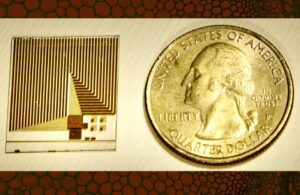
A team led by MIT researchers designed a sensor that could help screen for hard-to-diagnose cancers or metastatic tumors.
[Image courtesy of the researchers/MIT]
A team of engineers at MIT have developed a novel sensor that could detect molecules typically identified by naturally occurring cell receptors.
The prototype sensor can detect an immune molecule called CXCL 12. They say this could help develop a routine screening system for hard-to-diagnose cancers or metastatic tumors. The technology could also be used as a highly biomimetic electronic “nose,” according to an MIT news release.
“Our hope is to develop a simple device that lets you do at-home testing, with high specificity and sensitivity,” said Shuguang Zhang, a principal research scientist in MIT’s Media Lab. “The earlier you detect cancer, the better the treatment, so early diagnostics for cancer is one important area we want to go in.”
The team drew inspiration from the membrane that surrounds all cells. Those cell membranes feature thousands of receptor proteins capable of detecting molecules in the environment. The MIT team modified proteins to survive outside the membrane, anchoring them in a layer of crystallized proteins atop graphene transistors. Upon the detection of a target molecule, the transistors transmit information to a computer or smartphone.
The team says the sensor could potentially work to analyze any bodily fluid, like blood, tears or saliva. It could also screen for different targets simultaneously.
“We identify critical receptors from biological systems and anchor them onto a bioelectronic interface, allowing us to harvest all those biological signals and then transduce them into electrical outputs that can be analyzed and interpreted by machine-learning algorithms,” said Rui Qing, a former MIT research scientist and current associate professor at Shanghai Jiao Tong University.
Qing and PhD student Mantian Xue authored the study of the sensors, published in Science Advances. Zhang, Tomás Palacios and Uwe Sleytr were senior authors.
An alternative sensor approach
The team says its approach aimed to build sensors based on receptor proteins found in cell membranes. These can prove difficult to work with, though, because, once removed, they only maintain structure if suspended in a detergent.
Zhang, Qing and others previously found a way to transform hydrophobic proteins into water-soluble proteins. They swapped out hydrophobic amino acids for hydrophilic ones in a method called the QTY code.
“People have tried to use receptors for sensing for decades, but it is challenging for widespread use because receptors need detergent to keep them stable. The novelty of our approach is that we can make them water-soluble and can produce them in large quantities, inexpensively,” Zhang said.
Zhang and Sleytr worked to attach water-soluble versions of receptor proteins to a surface. These S-layer proteins, when crystallized, form coherent monomolecular arrays on a surface. They can also fuse with other proteins like antibodies or enzymes, as Sleytr previously proved. The team, with senior scientist Andreas Breitwieser, used the proteins to create a dense, immobilized sheet of a water-soluble version of a receptor protein called CXCR4. It binds to CXCL 12, which plays its part in human diseases like cancer. It also binds to an HIV coat glycoprotein responsible for virus entry into human cells.
The team named their sensor technology RESENSA (Receptor S-layer Electrical Nano Sensing Array).
“We use these S-layer systems to allow all these functional molecules to attach to a surface in a monomolecular array, in a very well-defined distribution and orientation,” Sleytr says. “It’s like a chessboard where you can arrange different pieces in a very precise manner.”
How the team applied their alternative method
MIT researchers attached their S-layer to a chip with graphene-based transistor arrays. Xue adapted the chip for coating with a dual layer of proteins. When a target molecule binds to a receptor, the charge of the target changes the electrical properties of the graphene.
This enables easy quantification and transmission to a computer or smartphone connected to the chip.
“We chose graphene as the transducer material because it has excellent electrical properties, meaning it can better translate those signals,” Xue said. “It has the highest surface-to-volume ratio because it’s a sheet of carbon atoms, so every change on the surface, caused by the protein binding events, translates directly to the whole bulk of the material.”
The team says they can coat the graphene transistor chip with S-layer receptor proteins with a density of 1 trillion receptors per square centimeter with upward orientation. This enables the chip to take advantage of the maximum sensitivity offered by the receptor proteins. The array chip integrates more than 200 devices, offering a redundancy in signal detection to ensure reliable measurements.
Using QTY code, the researchers say they can modify naturally existing receptor proteins that can then generate an array of sensors in a single chip. These sensors can screen virtually any molecule detected by the cells.
“This new system is the combination of different research fields as molecular and synthetic biology, physics, and electrical engineering, which in the team’s approach are nicely integrated,” said Piero Baglioni, a professor of physical chemistry at the University of Florence, who was not involved in the study. “Moreover, I believe that it is a breakthrough that could be very useful in diagnostics of many diseases.”